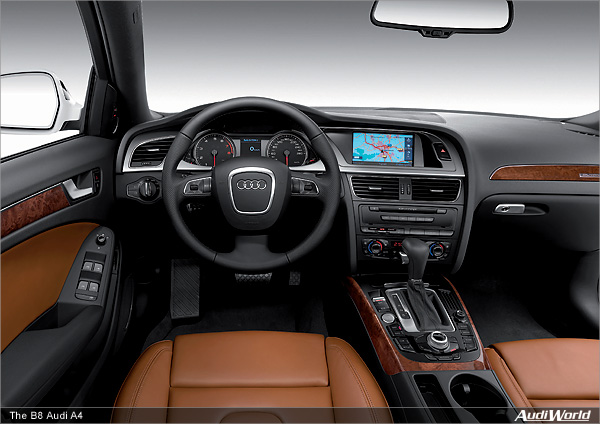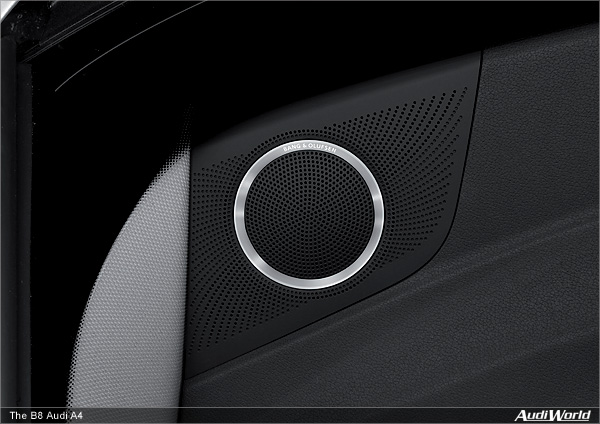The Audi A4: Multimedia Systems

Multimedia Systems The Audi A4 sets new standards in the midsize segment and the area of multimedia, one of the most exciting technical fields of the future, is no exception. The new saloon model is being launched with an attractive package of communication and entertainment technologies, the components of which can be matched as required to individual needs and preferences. The items include various audio systems, TV reception, two navigation systems, an iPod interface and an extremely convenient Bluetooth mobile phone link. The Audi A4 is supplied with a high-performance audio system as standard equipment: the chorus radio, which has a 6.5-inch monochrome display screen, a tuner module supplied from aerials in the rear and side windows, a 30-station memory and a CD player. GALA speed-dependent volume control is also standard. As on all audio systems for the new Audi A4, the chorus radio has the screen located separately from the controls, at the top of the centre console. The radios large switches and pushbuttons are located where they can be ideally reached and operated, between the automatic air conditioning and the ventilation outlets. The same controls also configure a number of secondary functions from the CAR menu in the new Audi A4. The chorus radio is coupled to a 4 x 20 watt four-channel speaker system. Two tweeters are located in the dash panel, two woofers in the front doors and two further speakers in the rear doors. The next radios up the scale are the concert and the symphony units. Both are from the new Audi audio generation and have a 6.5-inch colour display screen. Their controls are in accordance with Audis much praised MMI logic, and use a rotary pushbutton and large switches ideally positioned for intuitive operation. An optional lifestyle feature for the concert and symphony radios looks well ahead into the future of portable music: the Audi music interface (AMI). For many people, the ability to carry a library of music around with them, often stored in an iPod, and use it everywhere has become a firm element in their lives. The AMI interface is capable of linking to the customers iPod and allowing all its controls to be used. The radio display then displays the players menu structure with all its replay lists and additional information; operation is from the radio or the multifunctional steering wheel, another optional extra. The AMI links with a fourth-generation iPod; by means of a separate adapter cable, any other audio player with a USB 2.0 interface can also be connected. Its data will then be played via the cars audio system, though no control facility is available in this case. Audi has designed the AMI software as modular elements individual drivers are included in the memory for communication with the players and to enable their protocols to be read. If a new player comes on to the market, its driver can be installed quickly and easily as an update. Double tuner: two aerials, two receivers The concert and symphony radios contain a double tuner: a digital processor takes its signals from two aerials after pre-processing by the two tuners. One of the tuners plays the music, so to speak, while the other searches in a regular cycle through all the available stations in the background, in case a better signal can be received. This technology suppresses what is known as multipath interference, as caused for instance by signal reflections from buildings or in the mountains. It calls even weak stations down from the ether, since the two reception paths can be combined in such a way that the two aerials perform a direction-finding function. Quite apart from the AMI interface and the double tuner, both Audi radios are genuine all-rounders. They have an SD card reader (SDM = Secure Digital Memory) for audio files and a CD drive; both of these can also play music in the mp3 and wma formats. A six-disc CD changer is integrated into the symphony radio. As with the chorus radio, the 4 x 20 watt amplifier supplies four channels and eight speakers. The extended CAR menu control facilities are a further welcome feature. A highlight in the midsize class is the option of digital audio broadcasting (DAB) on the concert and symphony radios and on the navigation systems. Digital VHF signals are superior to the analogue standard in their dynamic range, clarity and spatial quality. DAB is in widespread use in many European countries, with almost complete coverage in Germany, Great Britain and Belgium. Audi DAB tuners compute the stereo signal by way of a signal processor, and prepare additional radio-text data in parallel. MMI: navigation system and highly convenient operation The next two even more complete equipment levels include a navigation system. In this case system control is carried out entirely at the MMI control terminal. As in the A8 luxury saloon, this is on the centre tunnel in front of the gear lever or tiptronic automatic transmission selector. Behind the control panel, the components are networked by an extremely high-speed optical conductor, with a special gateway functioning as the interface with the other control units in the car. For these full equipment versions, the customer can choose between MMI basic plus and the navigation system with DVD. MMI basic plus uses a monochrome screen, an arrow display and navigation data from a CD drive located in the glove box. An audio CD changer with MP3 capability is integrated into the centre console. The full MMI version (navigation system with DVD) is equipped with a double tuner and a seven-inch colour display as well as the CD changer. It obtains its navigation data from a fast, high-performance DVD drive. Speech control, an AMI interface and a TV tuner are options for the high-end system. Digital channels (DVB-T) can also be picked up; for safety reasons the screen displays them only when the car is stationary, but the soundtrack can be heard all the time. MMI basic plus and the navigation system with DVD are coupled with the ex-factory four-channel speaker system. Based on the concert and symphony radios, Audi is able to supply two high-class sound systems. The Audi sound system has a 180 watt rating and supplies an impressive, harmonious audio image to its ten speakers. As well as the usual eight speakers, there is a centre speaker in the dash panel and a 260 mm sub-woofer of 75 watt rating in the rear shelf. This system has provision for numerous alternative settings to be chosen.
State of the art: the Bang & Olufsen sound system Leading the way in technical and acoustical quality is the sound system from Bang & Olufsen. Derived from the one used in the A8 luxury saloon, it is no less of a delight to the ear in the new Audi A4. With its sparkling, brilliant reproduction, detailed resolution, precise spatial imaging and broad, well-defined frequency spectrum, this product from the Danish sound specialists satisfies every wish with its high precision and quality. Audi and Bang & Olufsen a cooperation between two partners with the same objectives. Both brands attach great importance to leading-edge technology, intuitive control and distinguished technically led design. To these must be added a no-compromise attitude to materials and workmanship, and in-depth competence in working with aluminium, a material that Bang & Olufsen uses for the speaker covers. The key element in the Bang & Olufsen sound system for the new A4 is an amplifier with a supreme 505 watt output rating. It processes signals digitally according to the manufacturers own surround algorithm, which enables the occupant of every seat to enjoy the full splendour of the systems audio quality. The numerous user settings include four sound emphasis points: the system analyses the noise level inside the A4 by way of a special microphone and makes selective frequency adjustments to its output signals. The Bang & Olufsen sound system has ten active channels and 14 speakers. Two three-way systems are active at the front, each with speakers in the door, the triangular mirror mounting and the dash panel. At the rear there are two speakers in each door. The acoustic choreography is rounded off by a centre unit in the dash panel, a 260 mm sub-woofer and two surround speakers on the rear window shelf. In accordance with typical Bang & Olufsen and Audi principles, this sound system was not merely dreamed up by the design engineers as a collection of bits and cycles per seconds, but has undergone repeated large-scale subjective comparisons with more than 50 people from various age-groups taking part. Bluetooth: perfect telephone integration Convenient, trouble-free use of the telephone has never been more important than it is today. The concert/symphony radios and those higher up the scale have a mobile phone preparation (Bluetooth): this integrates the telephone into the radio controls and also has speech control. The most elegant solution, however, is available for both MMI systems: the Bluetooth car phone for the D and E networks. This combines the advantages of hands-free operation with the strengths of the classic built-in car phone. For use with Bluetooth, the drivers mobile phone must support the SIM Access Profile; many of the current generation of mobile phones do this. The mobile phone is merely logged into the A4 system, which is able to carry out all its functions automatically when the driver inserts the ignition key. The mobile phone can remain in the users jacket pocket; the phone in the A4 takes over all the data from the SIM card via the Bluetooth wireless link, and also the internal memory up to 1255 entries. The mobile phone is then switched off, which avoids unnecessary GSM radiation and prevents the battery from running down. For optimal reception quality, the Audi Bluetooth car phone uses the A4s own aerial. It can be operated most conveniently by speech input, at the MMI controls or from the optional multifunctional steering wheel. To ensure excellent hands-free quality, an ultra-modern digital speech processor suppresses echo and road noise. Speech output is via the sound system, using the radios volume control. As an option for more discreet use of the telephone, a wireless handset with its own colour display can be supplied. It is housed in the centre armrest. The equipment, data and prices stated here refer to the model range offered for sale in Germany. Subject to amendment; errors and omissions excepted.
|

